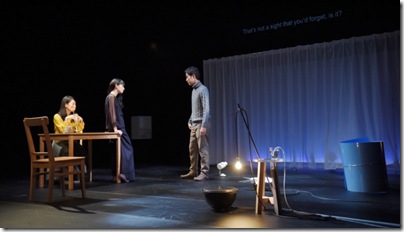Toshiki Okada’s “Time’s Journey Through a Room”
Photo. Courtesy of the Kunstenfestivaldesarts, Brussels, Belgium . Yana Meerzon sends in this comment on the production.
Playwright and director Toshiki Okada; Sound and set design Tsuyoshi Hisakado; Featuring Izumi Aoyagi, Mari Ando, Yo Yoshida; presented at the 2016 Kunstenfestivaldesarts, Brussels, Belgium, in Japanese with subtitles in French and Dutch.
Toshiki Okada is one of the most innovative theatre writers and directors from Japan, whose work has continuously appeared at the Kunstenfestivaldesarts in Brussels, Belgium. In his recent plays, Okada repeatedly attempted to reflect upon the consequences of the Great East Japan Earthquake of 2011. In Current Location (2012) and Ground and Floor (2013), he was addressing the pressing psychological and social issues of life/death interdependency – the source of much reflexion in Japan in the aftermath of the disaster.
Okada’s new play Time’s Journey Through a Room had its European premier in May 2016, also at the Kunstenfestivaldesarts in Brussels.. The playwright/director proposed one more exploration of the effects of the Fukushima tragedy on present day Japan, this time contemplating the collective trauma through the lenses of one particular story.
On stage, there is a young man who has lost his wife to the asthmatic incident, which took place in the wake of the earthquake. Echoing the “Noh theatre tradition” in which the ghosts of the deceased warriors often appear suspended between the world of the dead and the world of the living, waiting to be liberated into oblivion, and haunting the living people, Okada’s play features both the man’s dead wife Honoka as a ghost and his new love Alissa. All three characters are entangled in different but deeply interconnected time-zones. Honoka is stuck in the day of her death, when her time stopped and she died in the arms of her beloved husband. Alissa – who is also a narrator of this story – can only remember the day when she first came to the man’s apartment. The protagonist himself is desperately trying to leave his past behind, begging his ghost/wife to finally let him go, to let him forget her haunting image and the memories they shared together. His dream is to finally start living in the present. The questions of guilt and happiness, our impossibility to fully grasp the terrifying sense of oblivion and the overbearing rule of time, penetrate this production.
Visually, this philosophical quest is supported through minimalist staging. A large window at the back is covered with a curtain that creates the effect of white gauze; a small dinner-table and two chairs on the left, a glass of water standing on a stool next to the low hanging light bulb on the right. All objects suggest a modern apartment. The narrator, Alissa, asks us to close our eyes, when we open them we see a bare-foot young woman dressed in black, standing at centre stage, speaking of love and happiness to her husband. He is sitting with his back to the audience.
The actors’ movements and speech are slightly stylized. Everything takes place in slow-motion, with three characters inhabiting one space but passing by each other, not being able to communicate. The environment and the situation remind us of Jean-Paul Sartre’s No Exit as much as of a Noh play. In Sartre’s text the existential overlaps with the political, with three characters trapped for eternity within their personal misgivings and the realization of their political failures. Positioned between two strong theatrical traditions – classical Japanese theatre and Western theatre of the 20th century – Okada’s work is an example of the hybrid performative language, which marks the artistic experiments of many other works presented at this festival.
The sound plays a special role here. Constructed of the characters’ monotone dialogue, creaking sounds, dripping water, forgotten to be turned off TV, and occasional street noises, this soundscape also emphasizes the hybrid nature of the play. Not only does it signify the place of the fictional world positioned between the dead and the living, it also attempts to engage our senses and intellect. It stimulates our imagination through Honoka’s lengthy descriptions of the events that took place the day she died (shaking of the earth and everybody rushing to the parking lot away from their building); and its visceral effects on us through this soundscape.
At the end, Honoka leaves her husband to the living. However, her presence is forever ingrained in his mind, in his body, and in this apartment. The last image we see is the young man holding his new lover’s hand, both of them frozen in time at the kitchen table, in the apartment, which still has wallpaper, curtains and furniture that Honoka chose for her happy future. Time-wise, Okada’s work does not suggest much hope since this last image which appears to be a happy ending, suggests a return to the past, rather than a forward looking gaze into the future. –
